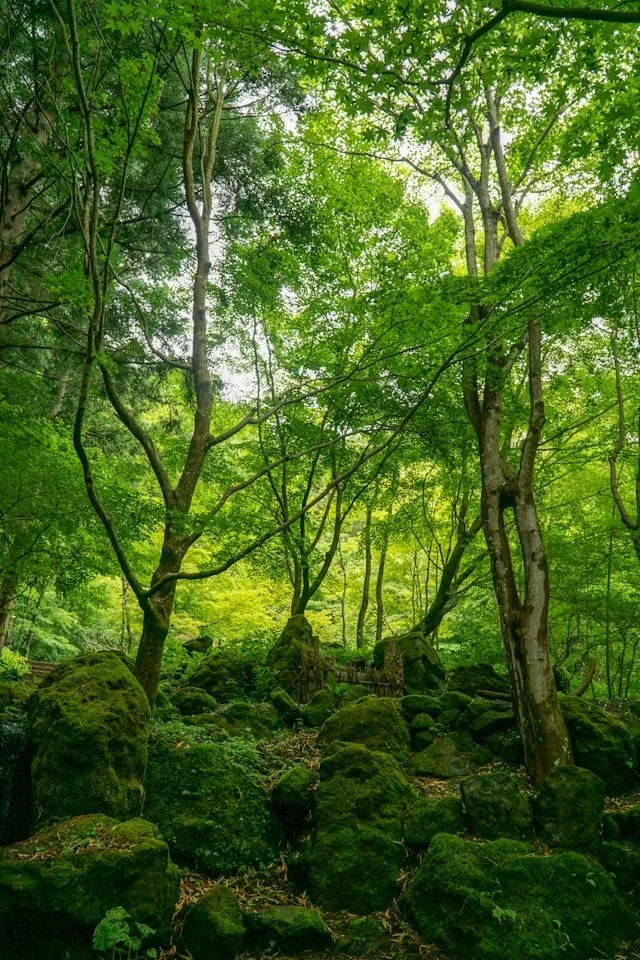The Remarkable Powers of Trees: How They Heal, Protect, and Sustain Our World
Photo by Aaron Katz on Unsplash
In my workshop, I transform wood into beautiful home décor pieces that bring the calming essence of nature into your living space. But before a piece of wood becomes a handcrafted bowl or elegant serving tray in my hands, it begins its journey as something far more extraordinary—a living tree. These silent giants that populate our landscapes are among the most remarkable organisms on Earth, possessing abilities that seem almost supernatural. As an artisan who works intimately with wood, I've developed a profound appreciation for the trees from which my materials originate. Join me as we explore the astonishing powers of trees and discover why protecting them is crucial for our collective future.
The Superhero Powers of Trees: Nature's Silent Guardians
Trees possess abilities that, if attributed to comic book characters, would make them the ultimate environmental superheroes. Their superpowers extend far beyond providing the beautiful wood we use in our creations.
Carbon Sequestration: The Climate Regulators
Perhaps the most crucial superpower trees possess in today's changing climate is their ability to capture and store carbon dioxide. A mature tree can absorb approximately 48 pounds of CO₂ per year, effectively serving as natural carbon sinks that help mitigate climate change. Through photosynthesis, trees convert carbon dioxide into oxygen and wood, locking away carbon in their trunks, branches, and roots for decades or even centuries.
This carbon sequestration capability makes forests Earth's natural climate control system. A single acre of forest can offset the carbon emissions produced by driving a car 26,000 miles. When I create my handcrafted wooden products, I’m not just preserving the beauty of the wood—I’m extending the carbon storage capacity of these trees even after they've completed their living cycle.
Air Purification: Nature's Filter System
Trees act as powerful natural air purifiers, removing harmful pollutants and particulate matter from our atmosphere. Their leaves and bark trap airborne particles while absorbing gaseous pollutants like nitrogen oxides, ammonia, sulfur dioxide, and ozone. A study by the U.S. Forest Service found that urban trees in the United States remove approximately 711,000 tons of pollutants annually.
This air-cleaning ability is particularly valuable in urban environments where pollution levels are highest. A single mature tree can provide enough oxygen for two to four people daily. When you bring one of our wooden creations into your home, you're connecting with this purifying essence that defined the tree throughout its life.
Water Regulation: The Hydrological Engineers
Trees are masters of water management. Their root systems act as natural water filters, removing pollutants and sediments as water percolates through soil layers. These same roots prevent soil erosion during heavy rains, while their canopies intercept rainfall, reducing runoff and allowing for slower, more controlled water absorption.
In urban settings, trees can reduce stormwater runoff by up to 60%, preventing flooding and decreasing the burden on drainage systems. By moderating the water cycle, trees help maintain watershed health and contribute to water security—a growing concern in many regions worldwide.
Biodiversity Support: Nature's Habitat Providers
A single mature tree can be home to hundreds of species, from microscopic organisms to birds, insects, and small mammals. Trees provide food, shelter, and breeding grounds for countless creatures, serving as essential anchors for biodiversity.
A single mature oak can provide habitat for an astonishing diversity of wildlife, hosting upwards of 500 different types of creatures from tiny insects to mammals and birds throughout its lifecycle. This biodiversity ensures ecosystem resilience and stability. When ecosystems thrive, they provide essential services like pollination, pest control, and nutrient cycling that benefit all life—including humans.
The Healing Touch: Trees and Human Wellbeing
Beyond their environmental contributions, trees offer remarkable benefits to human health and wellbeing—benefits that we aim to bring into your home through our handcrafted wooden products.
Physical Health Benefits: Nature's Pharmacy
Trees release compounds called phytoncides—antimicrobial volatile organic compounds that protect them from germs and insects. When humans inhale these compounds during activities like forest bathing (shinrin-yoku), they experience measurable health improvements, including:
Reduced blood pressure
Lower stress hormone levels
Improved immune system function
Enhanced anti-cancer protein production
Research shows that hospital patients with views of trees recover faster and require less pain medication than those facing brick walls. Similarly, neighborhoods with more trees typically report lower rates of respiratory diseases and better overall health outcomes.
Mental and Emotional Wellbeing: The Natural Therapists
Photo by Omar Ramadan on Unsplash
The psychological benefits of trees are equally impressive. Spending time among trees has been scientifically proven to:
Reduce mental fatigue and restore attention
Decrease anxiety and depression symptoms
Improve mood and boost feelings of happiness
Enhance cognitive function and creativity
These benefits explain why our customers often report a sense of calm and connection when they incorporate our wooden home décor into their living spaces. The grain patterns, natural textures, and organic forms of wood maintain a link to the restorative power of trees, even indoors.
Social Cohesion: Community Builders
Tree-filled neighborhoods foster stronger community bonds. Studies show that areas with abundant tree cover experience less crime, greater social interaction among neighbors, and increased use of outdoor spaces. Children in greener neighborhoods tend to play outside more, fostering physical activity and social development.
By bringing elements of this natural connection into your home through our handcrafted wooden pieces, you extend the community-building power of trees into your personal space, creating environments that promote conversation and connection.
Threats to Our Wooded Allies: What's at Stake
Despite their immense value, trees face unprecedented challenges worldwide. Understanding these threats is essential for appreciating why sustainable woodworking practices, like those we employ in our workshop, are so important.
Deforestation: The Great Loss
Approximately 15 billion trees are cut down annually worldwide, with only about a third of these being harvested sustainably. The majority fall victim to agricultural expansion, mining operations, urban development, and unsustainable logging practices. The World Resources Institute reports that we've lost 1.3 million square kilometers of forest—an area larger than South Africa—since 1990.
This massive deforestation threatens biodiversity, accelerates climate change, and disrupts indigenous communities that depend on forest resources. As artisans who work with wood, we're acutely aware of our responsibility to source materials ethically and sustainably.
Climate Change: The Growing Challenge
While trees help combat climate change, they're also vulnerable to its effects. Rising temperatures, changing precipitation patterns, and increasing frequency of extreme weather events put stress on forest ecosystems worldwide. These conditions create favorable environments for invasive species and pest outbreaks that can devastate entire forests.
Climate-related forest stressors include:
Extended drought periods
More frequent and intense wildfires
Expansion of insect ranges and reproduction cycles
Shifting growing seasons that disrupt ecological synchrony
Disease and Pests: The Invisible Threats
From Dutch elm disease to emerald ash borer infestations, trees face numerous biological threats. Global trade and travel have accelerated the spread of these problems, introducing pests and pathogens to areas where trees lack natural defenses against them.
When selecting wood for our handcrafted pieces, we often encounter the evidence of these battles—unique grain patterns and colorations that tell stories of resilience and adaptation in the face of environmental challenges.
Taking Action: Protecting Our Leafy Guardians
Given the remarkable benefits trees provide and the serious threats they face, what can individuals do to help? Here are practical steps anyone can take to protect and promote trees in their community.
Plant Strategically: Every Tree Counts
Even a single tree makes a difference. When planting trees, consider:
Native species that support local wildlife
Proper placement for energy efficiency (shade trees on south and west sides of buildings)
Diverse species selection to increase resilience against disease
Growth patterns and mature size to avoid conflicts with infrastructure
Support Sustainable Forestry: Speak With Your Wallet
By choosing products like ours—handcrafted wooden items made with sustainable practices—you contribute to responsible forest management. Look for certifications like FSC (Forest Stewardship Council) and support businesses that prioritize sustainability in their supply chains.
When wood is harvested responsibly, forests can continue to thrive and provide their ecological services while also supporting human needs. This balance is central to our business philosophy and practices.
Advocate Locally: Be a Tree Champion
Get involved in local tree preservation efforts:
Attend city council meetings when tree ordinances are discussed
Join or support local conservation organizations
Volunteer for community tree planting events
Educate neighbors about proper tree care and the value of urban canopy
Protect Existing Trees: Preservation Matters
Mature Old Growth tree Photo by Nathan Karsgaard on Unsplash
Mature trees provide far greater ecological benefits than newly planted ones. A 100-year-old tree cannot be replaced by 100 one-year-old saplings in terms of ecological function. Protect existing trees by:
Following proper care guidelines for trees on your property
Speaking up against unnecessary tree removal in development projects
Supporting stronger tree protection ordinances in your community
Helping maintain public trees through volunteer stewardship programs
Bringing the Power of Trees Into Your Home
At my workshop, I create handcrafted wooden pieces that celebrate the natural beauty and enduring strength of trees. Each bowl, tray, and decorative item carries with it the story of the tree it came from—a story of growth, resilience, and natural wonder.
When you choose one of my handcrafted wooden products, you're not just acquiring a beautiful object; you're embracing a piece of nature's most remarkable creation. The wooden grain patterns tell stories of seasons passed, challenges weathered, and life sustained. They bring the calming essence of forests into your living space, connecting you to the healing power of trees even when you're indoors.
I invite you to explore my collection of handcrafted wooden home décor and tableware, each piece thoughtfully created to showcase the remarkable beauty that only trees can produce. By choosing handcrafted wood products made with sustainable practices, you extend the legacy of trees and their countless contributions to our world.
Visit my online store today to discover how the remarkable power of trees can transform your home and connect you more deeply to the natural world that sustains us all.
Grayhill Woodworking LLC creates handcrafted wooden home décor and tableware using sustainable practices. Each piece celebrates the natural beauty of wood while honoring the remarkable trees from which our materials originate. Bring the healing power and natural warmth of trees into your home with our unique artisanal creations.




